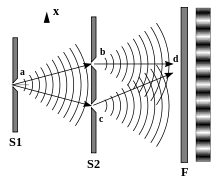Thomas Young used a single slit between the light source and the double slits. I can't understand why did he used the single slit, since the light from only one source is coherent already or isn't it? Does the narrow single slit make incoherent source coherent?
2 Answers
At the time of Young there were no lasers to provide coherent light. Incandescent light is incoherent because it comes from many sources and the same is true for sunlight. By passing the light through the one slit

he created a single coherent wave front . It is worth reading his description "on the nature of light and colors" in the link above.
Edit: I have not addressed the "why" a slit induces coherence. It has to do with wavelength : the size of the slit must be such that, similar to a diffraction grating, it diffracts specific wavelengths differently and also acts as a point source creating a coherent wavefrong. Here is an illustrated description of coherence. Here is a blog entry discussing coherence from thermodynamic sources .
- 236,935
"Thomas Young used a single slit between the light source and the double slits. I can't understand why did he used the single slit, since the light from only one source is coherent already or isn't it? Does the narrow single slit make incoherent source coherent?"
This answer is not to imply that Anna V's is incorrect.
One of the sources of confusion when learning about the double-slit experiment is that, sometimes you'll see a setup with the light-source directly facing the double-slit; whereas sometimes you'll see a setup with a single-slit intervening between the light-source and the double-slit. This might be what prompted the OP to ask the question.
If so, then the question should be answered by saying that some light-sources emit light that's spatially coherent enough to see interference, whereas some light-sources don't. If we leave lasers out of the discussion for a moment, then we can say that it's no coincidence that the closer and closer a light-source is to being a point-source, the more spatially coherent the light emitted from it, and hence the less one needs to intervene a single-slit between the source and the double-slit. For the point-source, emitting light in theory from a single point, and the single-slit, which could just as well be a single-pinhole, carry out essentially the same role in terms of making the light spatially coherent. So that, yes (to answer your second question), the single narrow slit makes spatially incoherent light coherent.
About lasers, they work differently in that, to put it most simply, they're not "point-sources" but emit spatially coherent light. Needless to say, you'd never see a double-slit setup using a laser and an intervening single-slit.
BONUS! - I'm going to end this answer with a further question for the OP or anyone else who's interested. If a small slit makes spatially incoherent light coherent, then why does the double-slit experiment require a point-source or an intervening single-slit at all? Shouldn't the two slits comprising the double-slit itself be all that's needed to make the light coherent enough to interfere? (Hint: tracing the light back from the interference to the source may help.)
- 539